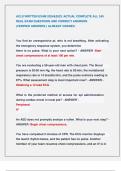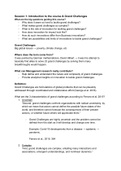ACLS WRITTEN EXAM 2024&2023 /ACTUAL COMPLETE ALL 240
REAL EXAM QUESTIONS AND CORRECT ANSWERS
(VERIFIED ANSWERS ) ALREADY GRADED .
You find an unresponsive pt. who is not breathing. After activating
the emergency response system, you determine
there is no pulse. What is your next action? - ANSWER -Start
chest compressions of at least 100 per min.
You are evaluating a 58-year-old man with chest pain. The blood
pressure is 92/50 mm Hg, the heart rate is 92/min, the nonlabored
respiratory rate is 14 breaths/min, and the pulse oximetry reading is
97%. What assessment step is most important now? - ANSWER -
Obtaining a 12 lead ECG.
What is the preferred method of access for epi administration
during cardiac arrest in most pts? - ANSWER -
Peripheral
IV
An AED does not promptly analyze a rythm. What is your next step? -
ANSWER -Begin chest compressions.
You have completed 2 minutes of CPR. The ECG monitor displays
the lead II rhythm below, and the patient has no pulse. Another
member of your team resumes chest compressions, and an IV is in
,place. What management step is your next priority? - ANSWER -
Administer 1mg of epinephrine
During a pause in CPR, you see this lead II ECG rhythm on the
monitor. The patient has no pulse. What is the next
action? - ANSWER -
Resume compressions
What is a common but sometimes fatal mistake in cardiac arrest
management? - ANSWER -Prolonged interruptions
in chest
compressions.
Pulseless V tach or V Fib algorithm - ANSWER -CPR 2 min, Shock at
120 Jewels, CPR 2 min, Shock at 120
Jewels, give 40 units of vasopressin, CPR 2 min, 300 mg
Amiodarone, CPR 2 min, 1 mg epinephrine, CPR 2 min,
150 mg Amiodarone
When you see a suspected asystole or PEA what are the first actions
that you need to take in order to ensure that is
the rthythm you see - ANSWER -increase gain on monitor,
check leads to make sure none have fallen off
Asystole/PEA - ANSWER -CPR 2 minutes, 1 mg every 3-5 minutes,
CPR 2 minutes, treat possible causes
,What are the 5 H's and 5 T's - ANSWER -Hypovolemia, Hypoxia,
Hydrogen ion, HYpo/Hyperkalemia, Hypothermia
5 T's: Toxins, Tamponade, Tension pneumothorax,
thrombosis (coronary or pulmonary)
What is the treatment if a patient is dead and in acidosis - ANSWER -
1 meq/kg Bicarb
What is the treatment for Hyperkalemia - ANSWER -amp of calcium,
bicarb, insulin (10 units) and glucose
What are some causes of a patient going in to Metabolic ACidosis -
ANSWER -aspirin, antifreeze
What is the treatment for Hypokalemia - ANSWER -give potassium
What is the treatment for Hypothermia - ANSWER -warm saline rapid
infuser, bear hugger, increase temp on vent
What is the reversal drug for opiates and the dosage - ANSWER -
Narcan 0.4-2 mg
What is the reversal drug for benzodiazepiens - ANSWER -
Romazincon 0.2 mg, 0.3, then 0.5 till a max dose of 3
mg
, What are signs of a patient being in cardiac tamponade - ANSWER -
JVD< purple from nipple line up
What is a good diagnostic tool to determine if a patient is in cardiac
tamponade - ANSWER -Echo machine to see if
there's
fluid
Wht is the treatment for Cardiac Tamponade - ANSWER -Pericardial
centesis ( 5th intercostal space midclavicular
line, needle in to
drain line)
What are the symptoms of your patient having a tension
pneumothorax - ANSWER -tracheal deviation, JVD,
difficulty
bagging, Low 02
sat
What is the treatment for a tension pneumothorax - ANSWER -needle
in 2nd intercostal space midclavicular line
What are some signs of a patient having a pulmonary embolus -
ANSWER -low sats, JVD





